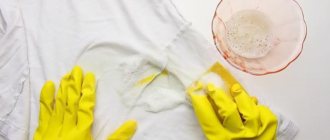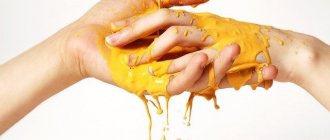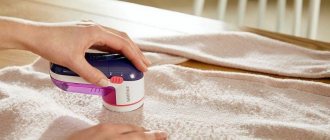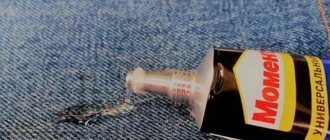Expert opinion
Evgenia Taran
Every person remembers how, as a child, they tore off a sticky, viscous substance - resin - from trees. However, not everyone knows that it is very difficult to remove it from soiled things. But with some knowledge it is quite possible to do this.
Therefore, further we will consider how to remove resin from clothes and other surfaces quickly and easily.
How to remove tar from pants?
Rubbing alcohol will help remove fresh stains. To do this, soak a cotton swab in alcohol and wipe the area of contamination. Alcohol also removes resin from delicate clothes that are not intended to be washed. Pine resin can be easily washed off if you mix 1 tsp.
Interesting materials:
How to determine a major transaction by balance sheet? How to determine citric acid? How to determine the maximum resolution of a monitor? How to define a small business? How to determine the naturalness of honey at home? How to determine working capital from the balance sheet? How to determine the main activity of a company? How to identify a rooster? How to determine fabric density? How to determine the sex of geese?
Features of removing various types of resin from clothing and other surfaces
There are currently two main types of resins:
- Organic origin. This group includes a resinous thick mass that is released by trees at the site of a break or cut. A similar substance is also released by the cones of coniferous trees. It is quite difficult to clean plant resin at home, especially coniferous resin. It is very sticky and has a thick consistency, so it firmly eats into porous structures such as fabric.
- Synthetic origin. For example, polyethylene, acrylic, polyurethane. This group has a lot of positive qualities and is used in various industries: to create glue, varnishes, and water-repellent primers. However, if such substances come into contact with the skin, serious allergic reactions can occur. Therefore, it is very important to know how to quickly remove resin from your hands and other parts of the body.
In most cases, you should heat the resin before attempting to remove resin from clothing or other surfaces. Or vice versa - wait a while so that it has time to dry. After all, if you try to immediately clean the uncured liquid substance from a stained surface, the stain will penetrate even deeper into its structure.
Methods for disposal on clothing and other surfaces
At the moment, several methods are known that will help to efficiently clean resin from clothing or home furnishings. Let's take a closer look at the most effective way to remove sticky stains.
Exposure to high temperatures
When the resin is exposed to high temperatures, it begins to melt. And this property must be used to remove it. This method is very suitable for removing pine resin from clothes made of thin translucent fabrics. To carry out the hygiene procedure you will need to do the following:
- place a paper kitchen towel on the ironing board;
- cover the napkin with a soiled cloth;
- put another towel on top;
- iron the contaminated area using the delicate mode.
The molten resin will gradually transfer to the paper. Towels will need to be replaced with clean ones as needed. After removing pine resin from clothing, you will need to remove the stain and wash the item in the washing machine.
High temperatures are ideal for removing sticky stains from leather surfaces. For example, it is quite easy to clean leather seats from tree sap using a regular hairdryer. The same method can be used to remove resin from linoleum.
Acetone, gasoline, alcohol
If you need to remove Christmas tree resin from clothes made of coarser fabrics, for example, from a jacket or down jacket, solvents will come to the rescue. It is best to use kerosene, gasoline or acetone for these purposes. However, if you do not have the listed liquids at home, you can use regular nail polish remover. To remove sticky mass from clothes, you will need to follow these steps:
- wet a small cotton swab;
- apply it to the problem area;
- wait fifteen to twenty minutes;
- wash the jacket or denim trousers in the washing machine using the appropriate cycle.
Helpful Tips:
- Remove dirt from the inside out.
- To prevent the resin stain from spreading throughout the fabric while removing it, dampen the cloth with water around the stained area. You can also sprinkle starch or talcum powder around the stain.
- Work from the edge to the center.
- It is convenient to apply the stain remover to minor stains with a cotton swab or pipette.
- When processing fabrics, follow these tips:
- Do not use acetone on silk fabrics;
- use alcohol mainly for white things, as it can destroy some types of paints;
- do not use bleach, as this product will not only discolor, but also damage the fabric;
- Use bleaches and alkalis only for white fabrics.
- When starting to remove tar stains, move from simple to complex: first use mechanical removal, then thermal, and only if these methods are ineffective, use solvents.
What not to do to remove resin
When working with resin contaminants, certain safety precautions must be observed. First of all, you should take care of your health and do not use aggressive chemicals to clean your skin and hair. The same warning applies to the safety of pets.
When working with substances containing compounds hazardous to health, you need to take care of special protection (respirator, goggles, gloves) and ventilation of the room.
The sticky and quickly hardening substance leaves stains on any surface that are sometimes very difficult to remove. However, if contamination is detected in time, you can choose an affordable product that will help get rid of traces of resin. You just need to patiently and consistently perform the necessary actions.
Type of fabric: what does it affect?
When starting to remove stains, it is necessary to take into account the composition of the fabric. When solving the problem of removing adhesive substances, it is important not to damage the item of clothing itself.
| Type of fabric | The best way to remove resin |
| Wool | Alkaline solutions, ammonia, starch and turpentine |
| Silk | |
| Cotton | Acetone, turpentine |
| Rayon or bologna | Refined gasoline |
| Nylon | Purified gasoline, alkaline solution, laundry soap |
| Leather | Vegetable oil |
| Membrane fabrics | Laundry soap and turpentine |
| Jeans | Ammonia and turpentine |
An interesting way is to remove it with egg whites.
Here, the property of protein to form a dry film on the surface is used. If there is a face mask, then you can make the same “mask” for clothes. Apply the beaten egg white to the stained area and let it dry.
A dry film will take resin particles with it when cleaning. This may not be the most effective method, but for delicate fabrics it can be tried.
Features of removal from various fabrics
In order not to harm the material, you should know what means and methods it can withstand. Often this information can be found on tags or labels of new clothing.
If they are not preserved, it is recommended to take into account the following recommendations:
- Cotton. Withstands acetone, alcohol, turpentine, heat treatment.
- Wool, silk . The use of ammonia and turpentine is allowed. Alkalies are not suitable.
- Bologna. Reacts well to gasoline. Does not tolerate vinegar and acetone.
- Nylon, nylon and other synthetics . Do not treat with gasoline or alkalis.
- Leather. Do not use organic solvents. Ideal for cleaning with oil.
- Jeans. Withstands ammonia, gasoline, acetone, turpentine.
- Membrane fabric . It is allowed to use turpentine and soap.
Prohibitions
When removing resin, you should remember some prohibitions:
- It is possible to remove adhering substances using sharp objects, for example, a knife, only in limited situations - to cut off the “drop” itself. In other cases, the use of a sharp object is not advisable, as it may damage the base material itself.
- It is not advisable to use solvent chemicals to clean hair and hands. Aggressive agents can lead to irritation, cause an allergic reaction and even cause wounds.
- If the chosen remedy for removing resin does not help, and you plan to use another one, the previous one should be washed off.
- You should not use force when removing the sticky layer from the surface - this may damage the surface.
- There is no need to rush to wash a stained fabric item, since regular washing does not remove the resin.
Removing stains and odors after cleaning
A person who has washed resin from clothes and other surfaces at least once knows that unpleasant stains may remain after the procedure. In addition, if sticky traces are washed off with a solvent or ammonia, a pungent odor will be present on clothes and home furnishings. Let's consider what will help solve these problems.
Mustard
To remove stains from synthetic fabric, you will need to do the following:
- dilute a small amount of dry mustard powder with hot water;
- wait until the resulting mass cools down and apply it to the problem area;
- after ten to fifteen minutes, soak the clothes along with the mustard paste in a soap solution for an hour;
- wash the item automatically.
Soda with salt
Using a similar method, you can remove stains and unpleasant odors from resin, only instead of mustard powder you will need to use salt marked “Extra” and baking soda. To prepare the cleaning agent, you need to mix the above ingredients in equal quantities and add a little water until it forms a paste. A similar product is also suitable for cleaning wood.
Peroxide
To tidy up white or light-colored clothes, you can use hydrogen peroxide. To do this you will need:
- treat the area with stains with active liquid;
- soak clothes in a weak soda solution;
- After an hour, wash the items in the washing machine.
Expert opinion
Irina Kovtun
In the absence of allergic reactions, peroxide can be used to carefully remove the resin from the skin.
What should you do first to remove a stain?
Fresh, small stains of resin that have not had time to dry are much easier to remove. If you act quickly, the likelihood of eliminating contamination without a trace increases.
When the resin just gets on clothing, skin or another surface, you must try to immediately remove as much of the adhesive mass as possible .
This must be done very carefully, without spreading the stain over an even larger area. It is convenient to use a napkin or rag for this purpose.
The thick mass, while it is fresh, can be lifted with a scraper or a regular spoon. After most of the resin has been removed, a residue may remain on clothing or other items.
Before proceeding with further processing, the soiled item must be prepared - remove dust and dirt . You also need to decide which product is suitable for dealing with stains based on the type of resin and type of material.
First aid
When you see resin, scrape it with something sharp. If you have a knife, great, you can use it, but if you don’t have one at hand, find a means at hand. Remember, the faster you get rid of the sticky substance from your clothes, the better. Otherwise, the resin will penetrate deep into the structure of each thread.
Once you have removed everything that you could with a knife (be careful not to damage the fabric itself), put the item in the refrigerator, or even better, in the freezer. The remaining tree resin will harden and become brittle and can be easily removed. True, after this there will still be stains from the resin. And further. Items made of very thin, delicate fabric cannot be placed in the freezer.
To remove tar stains from clothes, a knife and a freezer are a must. Only after manipulating them can you begin serious work on the stained item. Until then, all actions will be useless.
Epoxy resin
Epoxy resin is used to glue plastic together, creating a strong, permanent connection. Rather, it can be called almost instantaneous welding. Handling this substance should only be done with disposable gloves.
It will be extremely difficult to get rid of dried drops. Theoretically, acetone will “take” epoxy, but is it worth using it for clothes if you don’t want to see holes or loss of color on them?
One of the most effective and quick methods is heating. This option is only suitable for cotton or linen fabrics. Procedure:
- Heat water in a saucepan until boiling.
- Without turning off the stove, lower the cloth into the container for a few seconds.
- Take out your clothes and try to carefully remove the softened resin.
- If unsuccessful, repeat the procedure.
- Once the epoxy has been removed, wash your clothes as usual.
The soiled item does not need to be immersed entirely in boiling water; the contaminated area is sufficient.
You will have to tinker with delicate fabrics. Synthetics should be soaked in vinegar (3%). When the resin becomes pliable, you can carefully peel it off your clothes. After removing the resin, wash the item in cool water.
Funds at hand
When going into nature, people do not take cleaning products with them, but they may have, for example, wet wipes in their backpack.
- Surprisingly, soaking in these home remedies can remove uncured tar stains.
- You will have to put some effort into scrubbing off the dirt.
- As practice shows, some lotions and sunscreen also have this property.
A banal soda, which you take with you to quench your thirst, can in some cases dissolve the stain, the main thing is that it does not reach the hole in the clothing.
How to clean clothes
Soak a cotton swab in fir oil (you can buy it at the pharmacy) and apply it to the inside of the stained fabric. Use a second similar piece of cotton wool to wipe the greasy oil stain. The bottom swab will absorb all the dirt and the stain will gradually disappear.
Attention! To avoid white scorched spots, never use solvent or acetone!
Also, in hardware stores you can find special products that help get rid of oil stains. In the instructions for these products you can read which materials they are best suited for.
When using industrial chemicals, it is important:
- Read the ingredients carefully (avoid products containing formaldehyde, nitrobenzene, A-surfactants and other harmful substances);
- Be sure to use personal protective equipment (bandage, gloves, and sometimes special clothing);
- Avoid direct sunlight and open flames;
- Follow the instructions and dosages, do not exceed the recommended exposure time of the drug;
- Monitor the expiration dates of household chemicals (immediately get rid of expired products);
- Rinse surfaces thoroughly after treating them with household chemicals, and immediately ventilate the premises.
Vegetable oil
It may seem strange, but vegetable oil cleanses well from different types of dirt:
- Pour a small amount of any vegetable oil onto the resin and wait 5-6 minutes.
- Try scraping off the resin with a wooden spatula or the back of a knife.
- Repeat the procedure if you were unable to remove everything the first time.
- Wash off the resulting greasy stain thoroughly.
In this way, you can also remove resin that has dripped onto the carpet.
How to remove tar from a car
We take a dry rag and soak it in gasoline, then rub it over the stains from tar or bitumen. We wait about 3 minutes and wash off the stains from the body with the same rag. The paintwork of modern cars is quite durable, so don’t be afraid to use gasoline. The main thing is that the coating is not damaged before and during such treatment. Therefore, do not allow sand or other abrasive material to get on the cloth.
If your car is not new or you are still afraid to use gasoline, then modern chemical manufacturers offer you a wide range of special products taking into account all the features of car coatings. Sales consultants at any industrial chemicals store will promptly select the necessary product for you.











